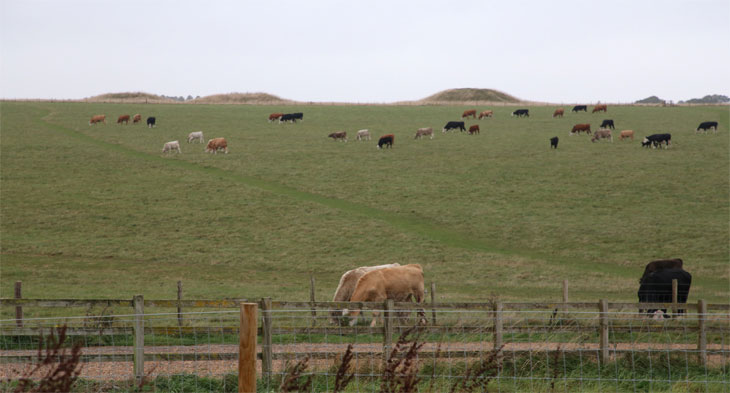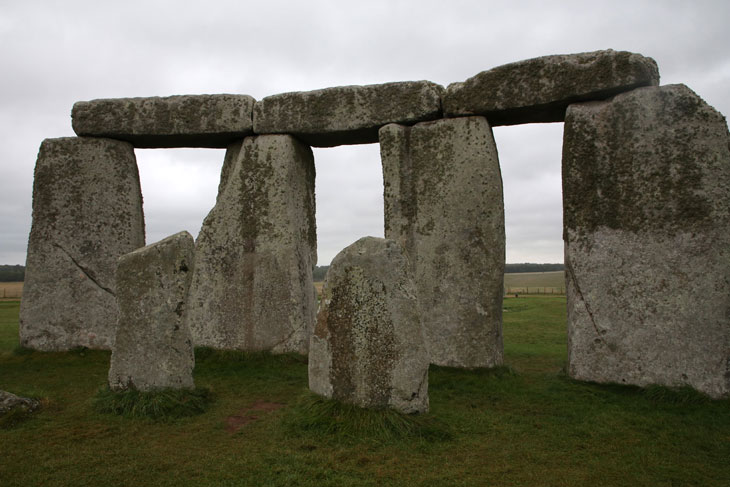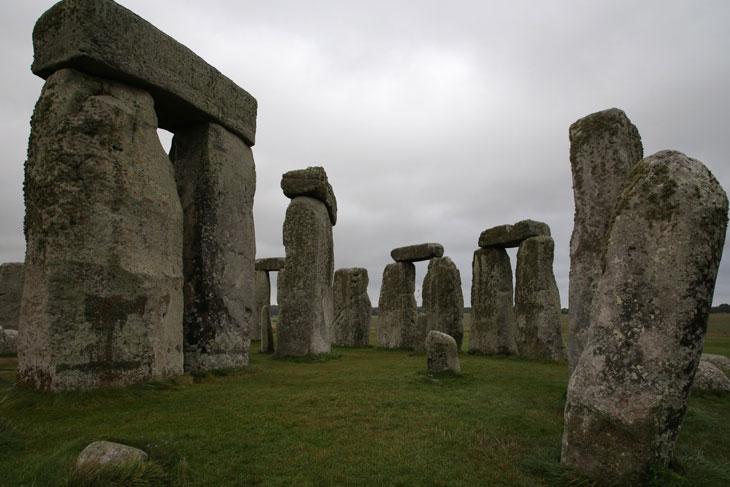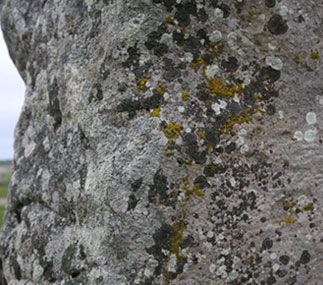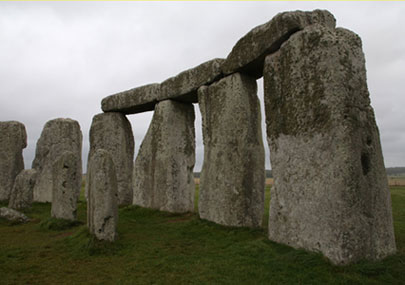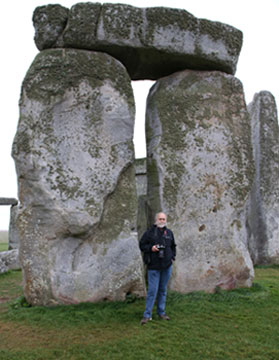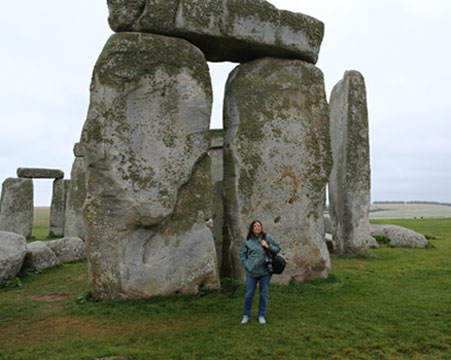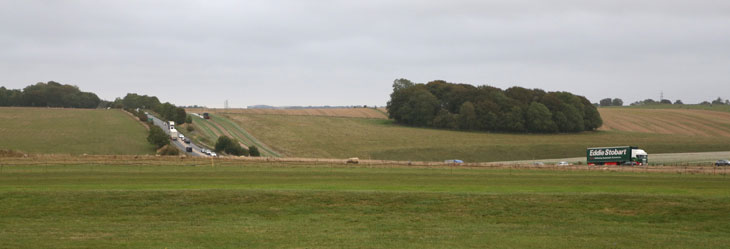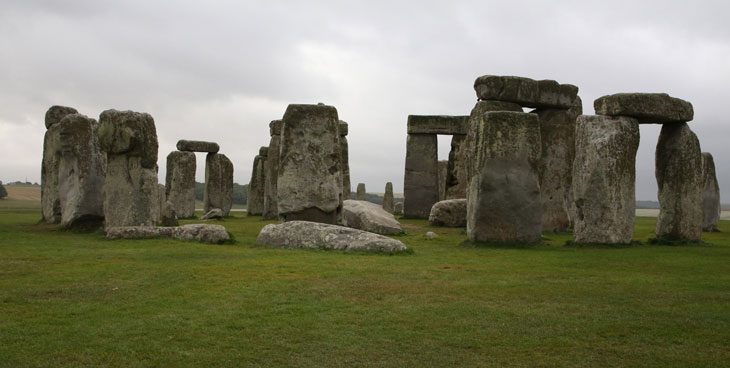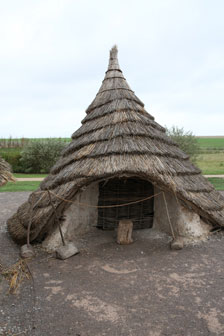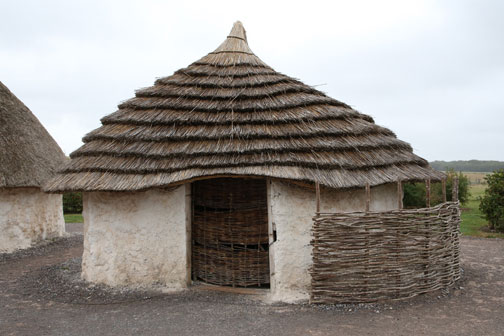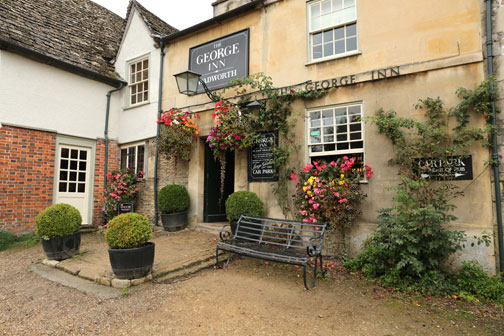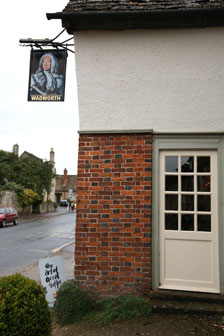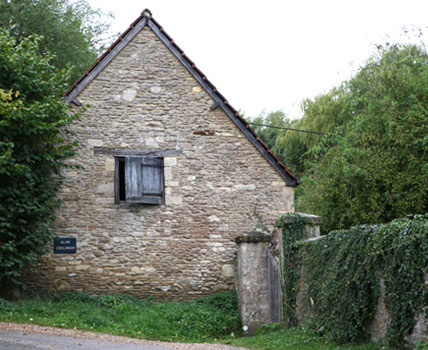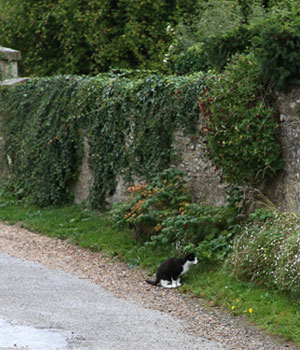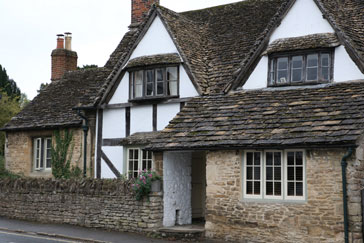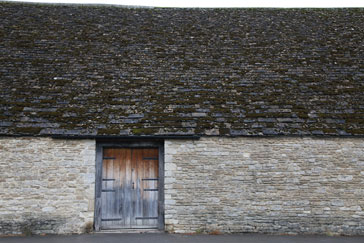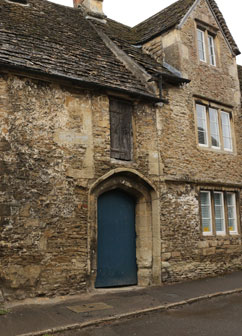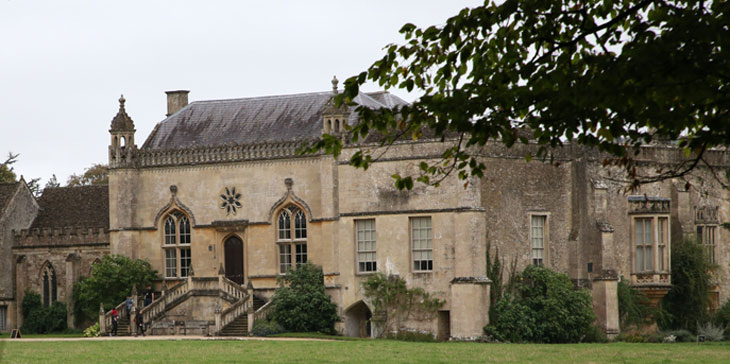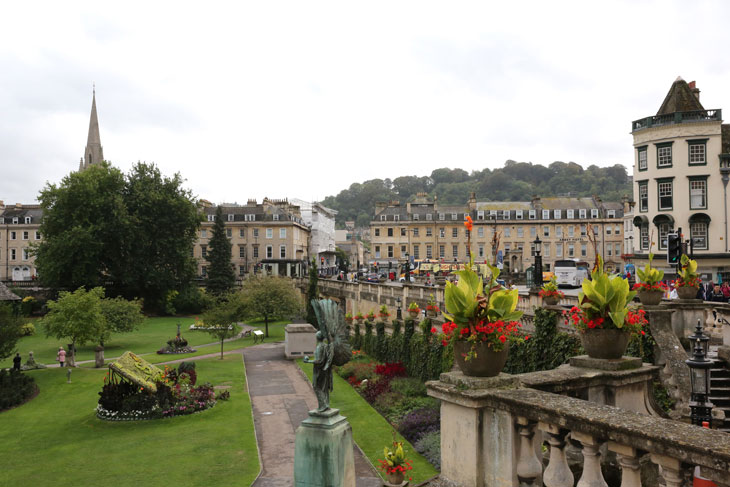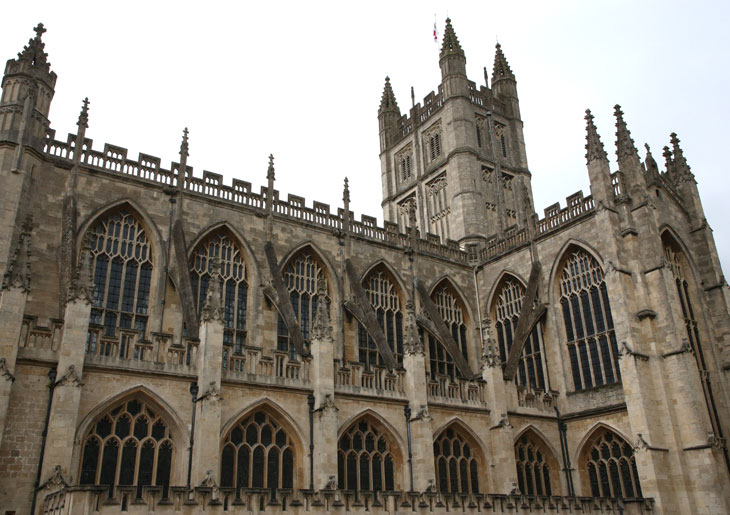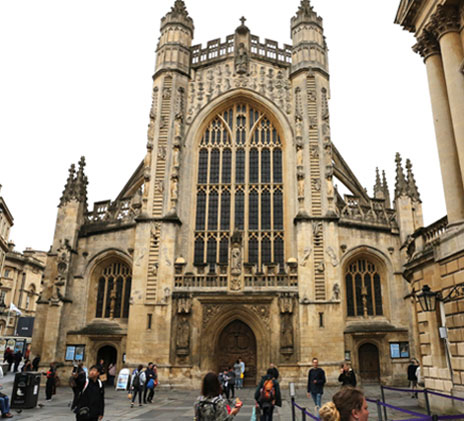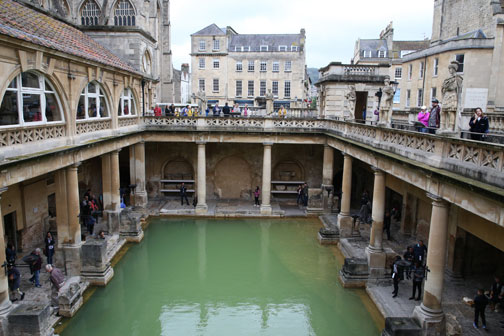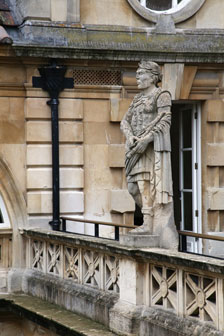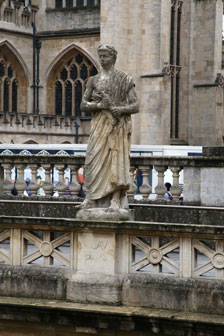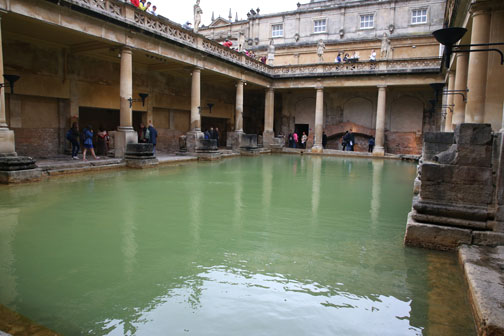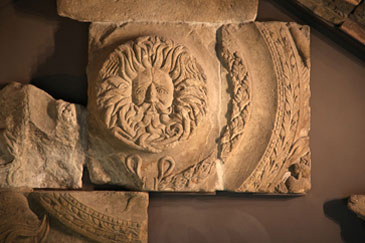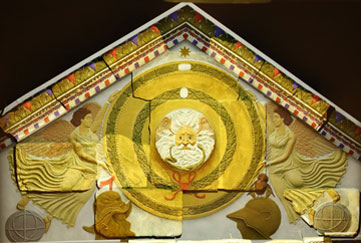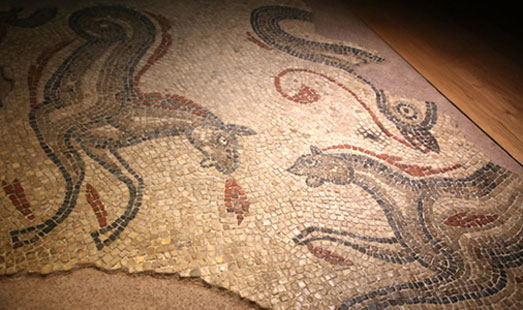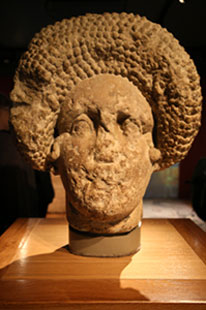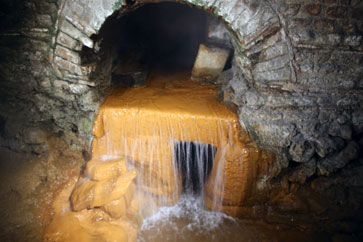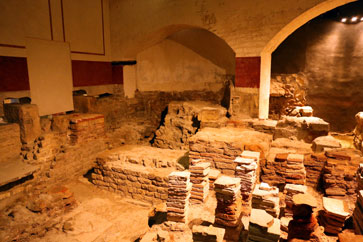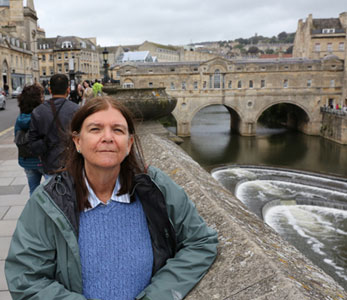Childhood Dreams
Tour of Stonehenge, Lacock, and Bath
It was well before dawn on our first morning in London, but instead of sleeping peacefully in our
comfy beds we were standing outside in the cold, drizzly rain waiting for the bus that would take
us on a "Special Access Tour" to Stonehenge. Normally, visitors to the site can only view the stones
from behind a low roped barrier, but several times a month special tours where participants
are permitted to walk among the stones are given at sunrise and sunset. Our first full day in London
was the only day of our entire visit when special access tours were given, and only the sunrise tour
had open slots so I jumped on it.
Many people are surprised to learn that Stonehenge is quite near a major motorway. This was our first
view of it from the bus.

At the Visitor Center, we boarded smaller buses which took us closer to the site. Cattle and sheep
grazed in the surrounding fields. The low hills in the background are ancient burial mounds
known as the Normanton Down Barrows. Excavation of these mounds by amateur archaeologists was a
popular hobby in the 18th and 19th centuries.
A stone circle resembling the one that exists today was built about 2500 BC. Much of southern
England was covered by forests at that time, but this area was covered by open fields much like
it is today. It was probably chosen as the site of the stone circle for that reason.
There are two types of stones at the site. The large stones are sarsen sandstone that probably
came from the Marlborough Downs about 18 miles to the north. The biggest sarsens are up to 30 feet tall and
weigh about 25 tons. The smaller rocks, called bluestones weigh between 2 and 4 tons and probably came from
Carn Menyn in western Wales more than 124 miles away. Most researchers today believe that they were dragged by
teams of people or oxen or possibly even carried on wooden lattices from the quarry to the monument site.
The picture on the left below is a close-up to show the texture of the sarsen stones.
Here we are standing in front of two sarsen stones topped by a lintel.
On the summer solstice, the sun rises behind the Heel Stone which sits outside the monument circle. It
is pictured on the left below. The picture on the second row on the right below is taken looking between two
of the sarsens towards the Heel Stone.
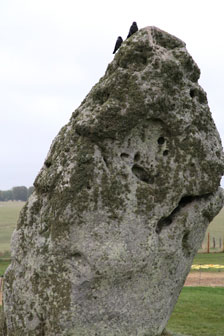
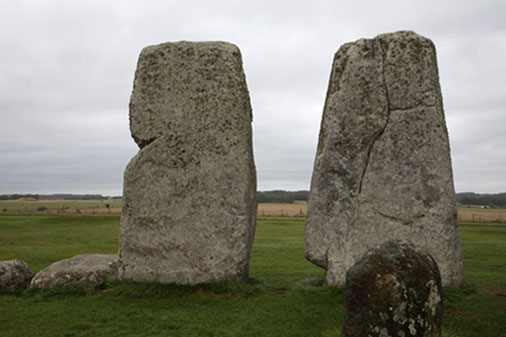
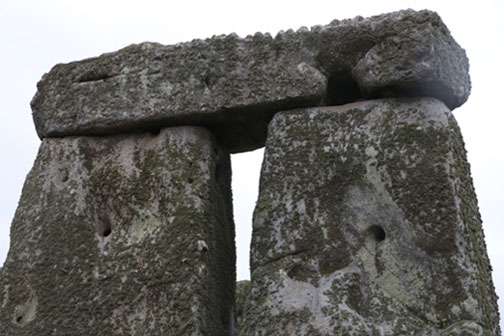
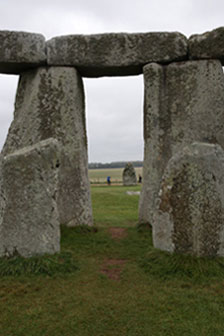
Stonehenge was given little respect over the years. Visitors chipped souvenirs from the stones and scratched their
names on the monument. By the end of the 19th Century, many of the stones were propped up with wooden poles,
and in 1900, one of the sarsens and its lintel fell over.
In 1915 Cecil Chubb bought Stonehenge, which had been privately owned, for 6600 British pounds at auction, and three
years later he and his wife donated it to the nation. It is now managed and protected by an organization called
English Heritage.
Although much has been done to restore the site, more work remains. The government plans to route the existing highway
through a tunnel to restore the integrity of the original landscape. This is the highway as it can be seen currently
from the site.
One last view of the monument.
We had hoped to be able to take a quick look at the exhibitions at the Visitor Center, but it wasn't
open yet so we wandered through an outside exhibit of models of the types of houses that stood in this area
when Stonehenge was built.
Next we were off to the atmospheric town of Lacock for breakfast at The George Inn. The village is often
used as a shooting location for films and television shows, and the inn itself dates back to the 14th
Century.
Below are some pictures we took as we wandered around the scenic town.
We also caught a quick glimpse of Lacock Abbey through the fence.
The final stop on the tour was the city of Bath. The natural hot springs at the site attracted the Romans who
founded the city of Aquae Sulis there in the 1st century AD. In the middle ages, it became a center of the wool
industry and later developed into a fashionable resort. Local limestone was used in the construction of the
city's buildings which are of classic Georgian design. The city has been designated a UNESCO World Heritage
site.
The bus dropped us off by this lovely little park known as the Parade Gardens.
It was a short walk to our destination - the remains of the Roman baths and the Temple of Sulis Minerva. On the
way we passed the impressive Bath Abbey. Since 757 AD, three different churches have stood on this site. The
present church is the result of restoration in the 1860's.
Sculptures of angels chimbing stone ladders to heaven adorn the front of the building.
Perhaps jet lag was setting in, but I found the museum to be a bit confusing. The ancient Roman baths were not
discovered and explored until the late 19th Century. What you see today is the ruins of the baths as they were presented
to the public back in the late 1800's. In Roman times, the Great Bath pictured below stood in a very large hall
with a ceiling about 130 feet high. Now it sits open to the sky and a visitor's first view is from a terrace lined with
statues of Roman emperors and governors of Britain that were sculpted in Victorian times.
This is a display showing the remains of the facade of the temple of the goddess Sulis Minerva which was also on
the site. The Gorgon's Head was one of her symbols. Researchers believe that in the time of the Romans, this section
would have been painted colorfully like the picture on the right.
The museum was very crowded so it was difficult to appreciate the items on display. The situation
was not helped by the fact that most visitors were moving through the exhibits quite slowly because they were
diligently listening to their audio guides. Here are
a couple of items I managed to photograph. The picture on the right is the stone head of a lady which was
found in a tomb near the baths.
The picture on the left below shows the Spring overflow tunnel constructed by the Romans. The water passes through
a drainage system and eventually enters the River Avon. The picture on the right is the ruins of a changing room.
When we tired of being jostled by the crowds, we wandered back out onto the streets of the city and
discovered Pulteney Bridge, pictured below. We didn't have time to get any closer, but it is actually one of only
four bridges in the world
which has shops built across its full span on both sides.
We're used to wandering about on our own when we travel so taking a tour like this is a bit of an adjustment. We
greatly enjoyed being able to walk amongst the stones at Stonehenge and it was interesting to stroll the streets of Lacock, but if
we were on our own I would have skipped the crowded Roman Bath museum and spent more time enjoying the unique
architecture of Bath.

